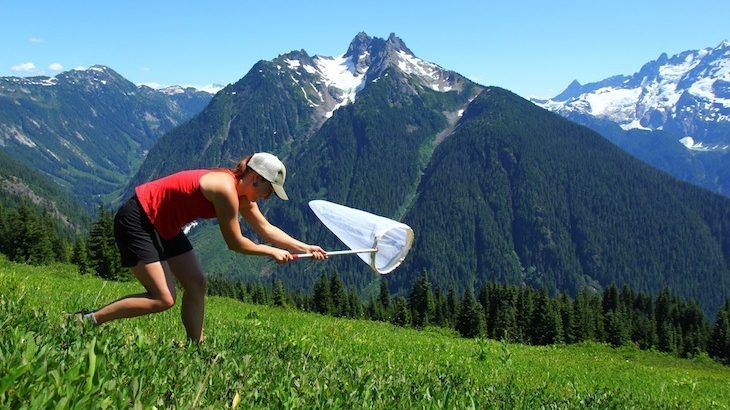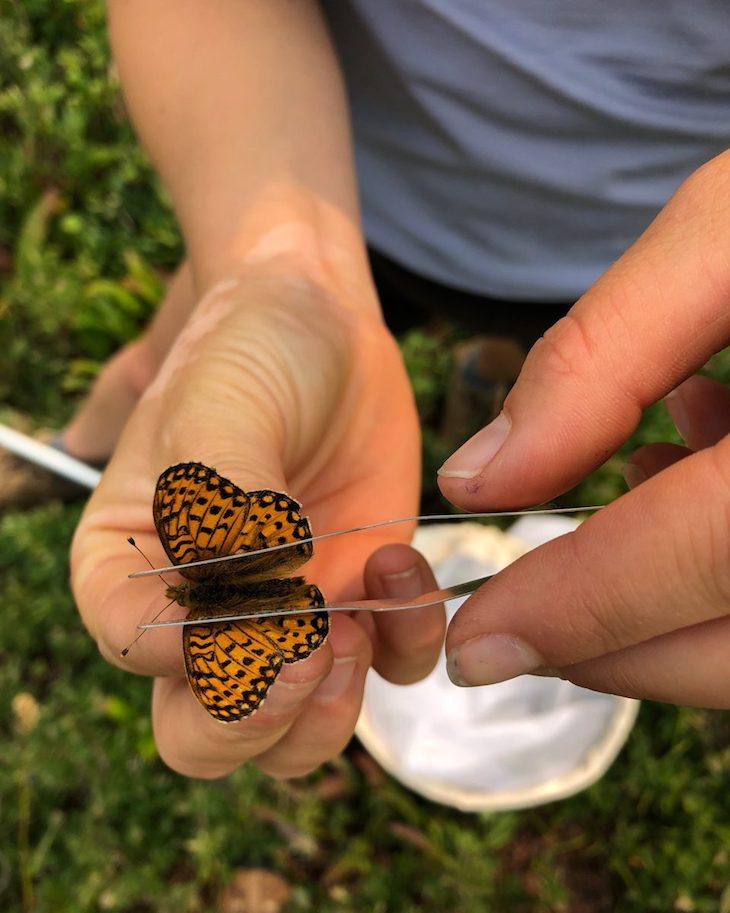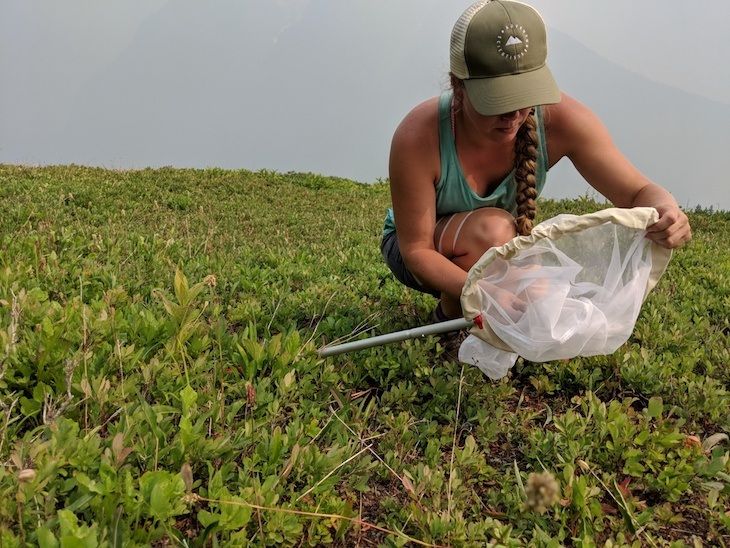What Can Butterflies Tell Us About Biodiversity?
These adventures find out

By Gemina Garland-Lewis
Standing among a subalpine meadow, butterfly net at the ready, I realize that I’ve never actually noticed how fast butterflies are. A few whiz by me, heading upslope, and they are gone before my muscles have even kicked into gear to chase after them. Veronica, my friend and field partner for this research project, laughs sympathetically from nearby. It will be her turn with the net soon enough. The world’s fastest butterfly has been clocked in at 37 mph, leaving the world’s fastest human in the dust. Luckily, we’re not going after this species in particular, but it definitely takes a keen eye and some cardio to follow them around.
The world’s fastest butterfly has been clocked in at 37 mph, leaving the world’s fastest human in the dust.


We’ve found ourselves in this meadow, surrounded by the peaks of the North Cascades and the watchful gaze of Mount Baker, as volunteers for Adventure Scientists – a Montana-based organization that partners conservation researchers with outdoor adventurers to collect data in remote areas. They refer to themselves as “special ops for conservation.” The project we’re working on, “Conserving Biodiversity: Pollinators” is a partnership between Adventure Scientists and the University of Arizona to collect the first large-scale backcountry dataset of butterfly abundance, diversity, and distribution in various high elevation, subalpine meadows of the American mountain West. With field sites across Montana, Washington, Arizona, California, and Utah, the data will be used to better understand how climate change will impact butterfly populations – including range shift, declines, and expansions – and how different species of these important wild pollinators will fare in various climate change scenarios. This is important because most of the data on butterflies comes from urban or frontcountry areas, when the real biodiversity hotspots are in the backcountry. “We can use this data to prioritize conservation action now before it’s too late,” says Michelle Toshack, Adventure Scientist’s Pollinator Project Manager.
After going through training, Washington volunteers like myself and Veronica were given a list of 13 options in the Cascades Range, all of them rated “moderate” or “difficult” in terms of access. The farthest site is nearly 10 miles from a trailhead, meaning you either have to be a fast hiker or be up for making your adventure an overnight. Toshack reports trail running, mountain biking, backpacking, and hiking as the various creative ways her volunteers make it to their field site. Our site, Goat Mountain, is nestled off the Mount Baker Highway, about a three-hour drive from our respective homes in Seattle. We’d be spending time in these mountains with or without the Pollinators Project, but being a part of this team not only helps us learn more about these landscapes that we love so much and the critters that call them home, but also lets us give something back to them by helping with conservation research.
As with many outdoor adventures, our day starts around sunrise if not before – we need enough time to get to our field site, hike in, collect data, and allow for some extra play time in the mountains. The first section of our trail is like many others in the Cascades – a seemingly endless number of switchbacks as it climbs out of the forest. As we continue up the switchbacks we see the ecosystem around us change – moving out of dense evergreen forest into a more open, shrubby, environment. Trail crews were working on this section during our first field visit, but just three weeks later when we head back it’s remarkably overgrown again. Most of this is salmonberries – one of my favorite foraged trail snacks – so things could be worse. Soon enough, the views open up and we enter the subalpine meadow habitat that is the focus of the Pollinator Project. Butterflies start to zig zag around us, but these ones are a little outside of our data collection zone and so the net stays put in my backpack. After a little more mileage and a chunk more elevation gain, we’ve arrived.


Our first order of business (other than lunch) is to collect some data on the wildflowers at our field site. Data on the plant species in these meadows go hand-in-hand with the information collected about butterflies, especially since most of the butterfly species in the subalpine are specialists, says Toshack. That means that, particularly as caterpillars, each butterfly species has a specific host plant that is dependent on to complete its life cycle. Collecting these data together can help scientists watch for “phenology mismatches” – when the life cycles of the butterfly and its host plant get out of sync due to environmental shifts like climate change. Veronica and I split up to cover more ground, then set a timer for 30 minutes and begin capturing images of as many wildflower species as we can find in the area.
When we’ve wrapped up with this, it’s time for the butterflies themselves, and we stick together as a team for this one. Our instruments include the butterfly net, a pair of forceps secured to a carabiner, and our iPhones. Like the plant observations, we upload images and information through the iNaturalist app, chosen by the Adventure Scientists team for this project because of its machine learning capabilities that help volunteers accurately identify the species they’re finding. Though we’ve practiced our netting technique at home, the excitement (and nerves) are higher in the field. We want to handle the butterfly as short a time as possible while still capturing the high-quality data we need. We’re after two images – one of the underside of the wings, and a second, top-down, view that requires us to use the forceps to gently separate and spread the wings. The whole process takes less than a minute and then the butterfly is on its way again. We spend an hour repeating this process with as many butterflies as we can net, trying our best not to capture the same individuals more than once.
Which brings me back to the tricky business of catching up with them. Toshack likes to challenge people who think that butterflies aren’t hardcore by giving them a net and the task of going after a fast-flying swallowtail – “You go chase that butterfly up in the alpine where there’s rocks and dirt clods and a bunch of ankle busters,” she says, “And I watch these super athletic people fail at catching butterflies. It’s hard – it takes a lot of skill and athleticism to catch them.” After learning that these subalpine butterflies overwinter in harsh conditions with heavy snowpack, I have even more respect for them. “Butterflies are survivalists,” says Toshack proudly.

Ideally, when the data collection is done, there’s still time for adventure. Our field site is only part-way up the trail that leads to Goat Mountain, and the backcountry beckons. On our first visit, we continued on the rough trail to the 6,650-foot summit, where 360 views welcomed us (as did Verizon, who texted to mistakenly welcome me to Canada) and every thigh-burning step of the 4000+ft of elevation gain was made worth it. Our second field visit was a different story, however, with a thick haze of wildfire smoke settling in from nearby burns in Washington and British Columbia. For the sake of our lungs and with no views to speak of, we call it quits on the adventure when we finished with data collection – a sad but necessary decision given the circumstances.
As we head down after our last visit, I think of something that Veronica asked me earlier that day – “What’s the most times you’ve been back to the same trail?” Looking back, I can remember hikes I’ve done up to three times, but never more than once or maybe twice in the same year. Being on the Goat Mountain trail multiple times, just a few weeks apart each time, has given me a new appreciation for the landscape and the ways I observe the environment shifting during the short alpine and subalpine summer season. I’m not alone, it seems. Toshack describes other volunteers (and herself) as feeling something similar – “It’s a great way to connect to the landscape,” she says. “You’re looking at the small things that you might not have noticed before, and it connects you to these organisms and to these landscapes which are absolutely incredible.” Ultimately, this feeling of connection and education is exactly what Adventure Scientists strives to create – a world in which volunteers become informed ambassadors for the species, places, and issues with which they work.
Interested in getting involved? Join the Global Pollinators Project anytime, anywhere, or look for updates on volunteer recruitment for the Western US Study described here starting in February 2019!
Check out our next Project: Beyond the Horizon
